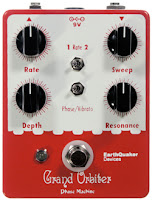 When Italian company Mark aka ‘Mark Bass & DV Mark’ release a new product you stop and pay attention.
When Italian company Mark aka ‘Mark Bass & DV Mark’ release a new product you stop and pay attention.YES! Mark Drum has released the Yes! A ground up design of what they believe a digital drum kit should feel and sound like and as critical as I am of electronic drum kits I was a tad impressed.
First thing that took my eye was the bussed drum stand design using RJ11 connectors, I couldn’t help myself but plug in a phone, nothing happened… but that’s beside the point. I love how clean it looks and the flexibility it allows you in regards to pad placement. The patented “smart pad” design means the signals are processed inside the pad which allows you to plug the pad into any of the RJ11 connections on the frame and the sound module will know what it is.
As is always a preference of mine, the kit adopts the use of your own hi hat stand and bass drum pedal. You can expand your Yes! with additional pads which can be assigned within the module. The module gives you 8 standard inputs and 4 additional inputs, Midi in/Midi out, aux in, headphone and usb connectivity.
Once I’d tended to the setting up of the kit, which was fairly painless I immediately started playing the bass drum pad. Although my first impressions of the rubber style pad with a reversed beater where negative it completely surprised me and turned out to be the best electronic bass drum pad I have ever played. The mesh pads weren’t anything revolutionary but if anything actually made you work a little harder than other makes, which I enjoyed.
The sounds were impressive and quite possibly the best I’ve heard! Forever I have wanted to hear more natural representations of drum sounds and a more familiar balance of those sounds from an electronic kit. I had someone comment on how they thought the crash cymbal was really loud, to which I replied “but that’s what happens on an acoustic kit doesn’t it?” Mark Drum have gone for a much more “acoustic hearted” approach accounting for right hand and left hand hits with an impressive 512 levels of velocity.
Now for the really good news! The sounds do not stop at the 24 pre-set kits Mark Drum give you, towards the end of this year (don’t quote me on this) Mark Drum will be releasing artist series kits for upload to your modules giving you access to more sounds in future.
So have Italian company Mark delivered once again? YES!
For those who need the flexibility to make standard std phone calls via there digital drum kit stand.
Not for those who want to play the Purdy shuffle
8.5/10
Review by Danny Yoghurt

























